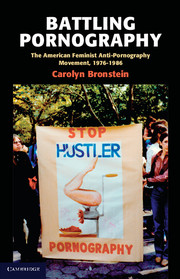Book contents
- Frontmatter
- Contents
- List of Figures
- Acknowledgments
- Introduction: Battling Pornography
- 1 Seeds of Discontent
- 2 Male Violence and the Critique of Heterosexuality
- 3 Have You Seen Deep Throat Yet?
- 4 “I'm Black and Blue from the Rolling Stones and I Love It!”
- 5 Something Inside Me Just Went “Click”
- 6 Growing Pains
- 7 Porn Tours
- 8 The New Lay of the Land
- 9 Anti-Pornography Comes Undone
- Conclusion: Porn Is Here to Stay
- Bibliography
- Index
- References
Introduction: Battling Pornography
The American Feminist Anti-Pornography Movement, 1976–1986
Published online by Cambridge University Press: 05 June 2012
- Frontmatter
- Contents
- List of Figures
- Acknowledgments
- Introduction: Battling Pornography
- 1 Seeds of Discontent
- 2 Male Violence and the Critique of Heterosexuality
- 3 Have You Seen Deep Throat Yet?
- 4 “I'm Black and Blue from the Rolling Stones and I Love It!”
- 5 Something Inside Me Just Went “Click”
- 6 Growing Pains
- 7 Porn Tours
- 8 The New Lay of the Land
- 9 Anti-Pornography Comes Undone
- Conclusion: Porn Is Here to Stay
- Bibliography
- Index
- References
Summary
Beginning with Betty Friedan's 1963 analysis of the role that women's magazines and advertising played in normalizing female subordination within patriarchy and consumer capitalism, media representation provided a significant source of concern for the women's movement. Media constructions offered women limited roles, typically the happy housewife and mother, or the sexual object whose primary function was that of male plaything. Feminist scholars throughout the 1970s paid serious attention to advertising and found that women were rarely depicted in professional working roles or shown without the presence of a male escort in public. Women were primarily featured in ads for cleaning products, clothing, and home appliances, whereas men were shown in advertisements for cars, travel, and banks. Building on this body of image studies, activists and academic researchers including Lucy Komisar, Midge Kovacs, Jean Kilbourne, Gaye Tuchman, and Erving Goffman argued that this visual environment created and maintained conditions of gender inequality.
By the mid-1970s, the “limited roles” critique of sexist media representation expanded to include insights derived from the radical feminist critique of heterosexuality. Feminists looked with new understanding at images that conflated female sexuality and violence, and claimed that they functioned like training manuals for young men growing up in a patriarchal society organized around the domination and oppression of women. Sexually violent media images encouraged the pervasive culture of male violence, contributing to the epidemic of rape and battering newly discovered within the consciousness raising groups popularized by radical feminism.
- Type
- Chapter
- Information
- Battling PornographyThe American Feminist Anti-Pornography Movement, 1976–1986, pp. 1 - 24Publisher: Cambridge University PressPrint publication year: 2011



